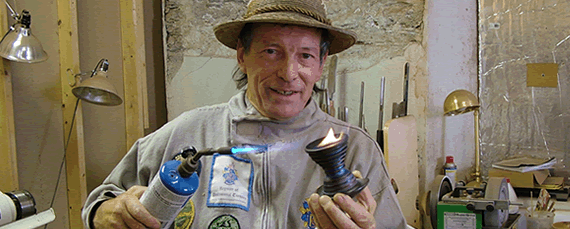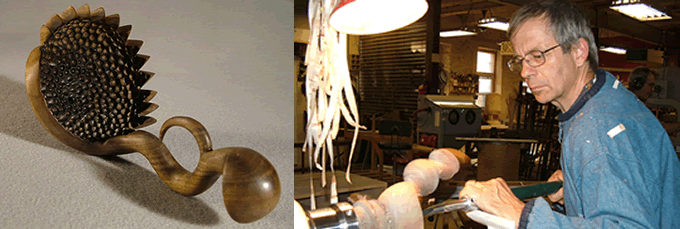
There is nothing parochial about the International Turning Exchange (ITE); this is born out by the number of residents who have participated from many parts of the globe over the last ten years. For me an indicator of the programme’s great success was the number of past residents who chose to return to Philadelphia to repeat the experience. I see the ITE as a ‘melting pot of artistic creation’; dare I say, as unique for its time as was the 19th century English arts and crafts movement or the French impressionists! A prime mover in the world of wood-art.
This is some melting pot! I see the essential ingredients as; a group of artisans from a variety of cultures sharing a love of their material, which for the most part is wood. Collaboration, a sharing of individual knowledge, pushing artistic boundaries, listening to other points of view, or not, sometimes having to compromise, these are all features of the ITE programme. It has been a fantastic recipe for learning from ones peers. For me, experimentation is the key component. Experimentation with form, function, texture, colour, narrative and ’awareness of spatial dimension’ (yes, I just mean size) all play their part. The pieces’ emanating from the ITE decade, and their creators, is now celebrated in the sumptuously illustrated book entitled, ’Connections’. ‘Connections’ confirms the raison detre of the ITE.
Rather than the annual two month period, this special ITE reunion was for an intensive five days. The well equipped workshop of local furniture maker Jack Larimore was generously made available,
The wood pile was the main source of raw material for the ITE residents. This wood was supplied by a nice man called Gus. Gus works for the city council removing unwanted trees from the street environment, and being a hobby woodturner has a good understanding of our requirements. He also took great interest in what we, a rag-tag looking group of world wide ‘woodies’ were creating from it.
Fellow Frenchmen Alain Mailland and Christophe Nancey were amongst the first to pick over some choice logs, they were each to produce very differing pieces. Alain mounted a large log of, I think Cherry, on the lathe. Most people would have found it almost imposable to imagine the wonderfully delicate, organic work that slowly emerged, after much turning, carving and steam bending, from that freshly felled log.
I think one of the things that attract visitors to woodturning shows and seminars is the expectation of seeing a diverse display of work, both to admire and for inspiration. There will be the studied work of those who commit every aspect of their design to paper before picking up a tool. Then there will pieces created by the free-spirits whose work will evolve almost as if they were created by Mother Nature herself. Alain Mailland and Christophe Nancey are definitely in the free-spirit brigade.
The ‘hollow sphere’ form is at the centre of much of Christophe Nancey’s recent work. Watching a lathe artist working, especially one who never repeats their pieces, often begs the question; do they know from the outset what the completed item will be, or is a truly organic process that slowly evolves? Certainly, we all kept a watching brief on Christophe’s sphere. Turning the hollow sphere was only the beginning, a blow-torch was used to dry the wet wood from the inside, it was then textured, painted, and adorned with small rose-tinted cut glass fragments and mounted on a tapered turned spike.
The French were by far the largest group of participants from overseas. They have a very strong woodturning tradition, in recent years this has provided the world of woodturning with some exceptionally creative craftsmen. Jean-Francois Escoulen epitomises this phenomena. Pre ITE he worked quietly in his workshop as a production turner, now he is king of the off-centre turners and travels the world entertaining lesser mortals with his magic. Jean Francoise (pic below) created a wonderful ‘sunflower’ ladle in Black Walnut whilst enjoying the friendly banter that is part of the ITE experience.

Marc Ricourt and I were both members of the 2001 residency. In common with American turner Mark Gardner of the same year, Marc draws much of his influences from the native artefacts of the Pacific Rim. Marc was quick to turn an interesting form out of some unidentified log from the pile, and after what Marc does to the timber I think the identity of the species is irrelevant! Off the lathe Marc is a gentleman, but turning can bring out his brutal side, how many turners do you know who attack their material with a chainsaw, and create a master-piece?
Israeli lathe artist Eli Avisara collaborated with Mark Gardner to fashion some textured and coloured end grain roundels. These roundels were incorporated as applied decoration to Mark’s antique inspired boxes. Eli would be the first to admit the roundel idea was inspired by the spinning tops of Bonnie Cline, but a little lateral thinking resulted in a new application for end grain ‘chatter’ work. Collaboration between artists/craftsmen often yields innovative work. This was an interesting piece, and like many others, would not have been created without the coming together of diametrically opposed creative minds.
New Zealander Graham Priddle produced a goblet, and then enlisted the collaboration of Australian Terry Martin. Terry took a head-only digital picture of all who were working in Jack Larimore’s workshop. He then printed the results and attached the heads to ‘bodies’ culled from a variety of glossy magazines and pasted them on to the vessel to produce a collarge, this was a great fun piece and much liked by the other artists. The work was duly signed by all the participants and sold well at the auction.
Normandy artist Laurent Guillot supplied each of the ITE participants with one of his specialities, a turned lace wood ‘Tube’. We were all invited to create something interesting from these. No one can pretend that this was great art, but great fun yes, it is interesting how each lathe artist approached decorating Laurent’s tubes in his/her own way.
Betty Scarpino worked tirelessly on a gilded ‘crescent’ piece. Betty is living proof that what may be perceived by some as a ‘mans’ world, is in fact all encompassing. Betty, along with a number of prominent women woodturners is an inspiration to the ‘fairer sex’.
Nothing lasts for ever and before long the ITers once more departed Philadelphia, many to cross the oceans that separate us. But! They’re ready I’m sure, that if the call comes once more, they will be back together with newer recruits, to celebrate the twentieth anniversary of the International Turning Exchange.
Visit the International Turning Exchange website.
